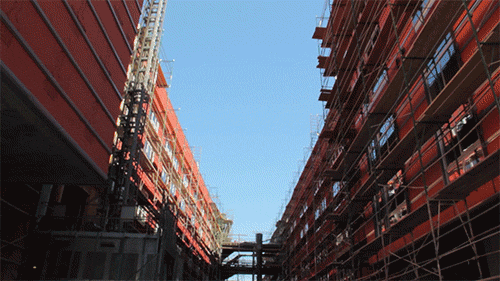Chinatown: The Tale Of Three Plazas

The plaza will be a very different scene from the one next door.
Just a block down the street is a quiet two-story office building called Mandarin Plaza. Garnered with a crimson red pagoda at the top, the building is distinguished by its bright orange walls.
Light foot traffic and nameless facades might be mistaken for vacancy. But behind the plain exteriors of these spaces are art studios and galleries.

“The whole reason why people are interested in Chinatown besides the architecture and some of the shops is because this is kind of a creative hub in L.A.,” Nielsen says. “I love this place. It’s a great location.”
Nielsen has been in this space for about four years. “Most artists survive on their wits and the little incomes that they have,” he says. “So they look. They seek out places that are cheaper to live.” In addition to the low rents, he says he came for the calm, tranquil and relaxing environment.

The project will fill a two-acre space with 450 parking spots and 237 apartment units. Of those units, 53 will be set aside for low income. The bottom of the five floors will be filled with various shops. The plaza lines the elevated MTA Gold Line station that acts as an entrance into Chinatown’s Historic District.
“We don’t necessarily want to create a vision for Chinatown,” says Nate Arnold, the Senior Construction Project Manager with Forest City Enterprises, the plaza’s developer. “We want to participate and augment the community that’s already starting to develop.”

“The neighborhood may change. I think the characteristics of the neighborhood won’t.” Arnold says he believes the mix of artists, cultures, and languages will still define Chinatown in the wake of the new development.
Arnold says he thinks the greater downtown area in general is experiencing a robust period of change and growth. “I feel that’s spilling over and that change is coming to Chinatown,” he says.
It’s the kind of growth that some businesses have been longing for quite some time—especially at the businesses directly across the street from Blossom Plaza.

The plaza is filled with tourist gift shops and restaurants. “Every year, business has been declining slowly,” says Dick Wong, the owner of Golden Dragon Gifts, a family business that started in the 1950’s. “The demand for our products are not as demanding as before.”
Wong says he and other merchants have seen business slowing down over the years. He also says Chinatown can be a last choice for tourists in L.A. “With the plaza, we’re holding our breath because we’re hoping for a lot of things getting better,” Wong says. Wong hopes that Blossom Plaza might revive the plaza with foot traffic and customers.

With that, he thinks that maybe he would have to convert his shop into a store of convenience items instead. “Maybe that’s a trend. We will change into that storefront instead of souvenirs and gifts, but that’s for some younger entrepreneur to find out,” Wong says.
But for artists like Nielsen, Chinatown’s current state is just the way he likes it. “I can’t actually imagine working anywhere else in this city,” Nielsen says. “And as long as there’s interesting neighborhoods for artists to come into and to work in, we’ll continue to populate at least the core of L.A.”
For the time being, there’s still six months left on the clock. And with artists like Nielsen and long-time Chinese business owners like Wong in mind, Nielsen will carry forth the developer’s vision. “Chinatown, like all of our neighborhoods, has a great identity,” Arnold says. “We hope that we can further that with our project.”
Contact Staff Reporter, Cameron Quon at .










